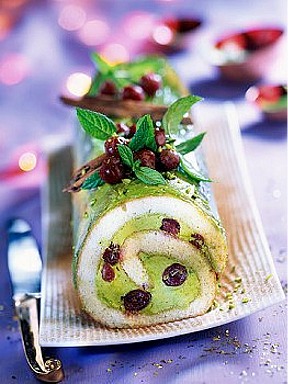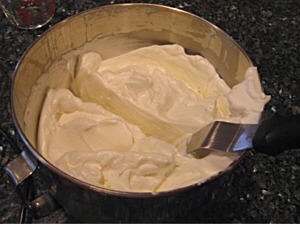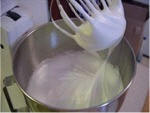
stock photo
Pavlova is a meringue based dessert named after the Russian ballet dancer, Anna Pavlova. It is believed to have been created to honor one of her tours to Australia in the 1920's. Instead of a traditional round sweet meringue base, topped with whipped cream and fresh fruit, this recipe makes one that rolled up with whipped cream and fruit. This luscious dessert is crispy on the outside and has a soft, marshmallowy interior. Although the original calls for cornstarch, at Passover you can use potato starch instead of cornstarch. Just about anything can be rolled into the pavlova, from chocolate mousse to whipping cream with fresh berries. Because the meringue roll tends to be sweet, I like to pair it with a tart filling.
CAKE RECIPE HELP
EASY PASTRY CREAM, LIME FLAVOR VARIATION / recipe alone
INGREDIENTS
3.9-ounce package Vanilla or Lime Instant Pudding (or any flavor you select)
1 3/4 cups 2% or whole milk
1 teaspoon vanilla extract
1/2 teaspoon lime extract or 1/4 teaspoon lime oil
INSTRUCTIONS
1. Beat pudding mix with milk with a whisk 2 minutes.
2. When the pudding is made, stir in the extracts.
3. Press plastic on the surface of the completed pie filling and refrigerate for at least 1 hour or until firm and well-chilled.
STORAGE
The filling needs to be kept refrigerated.
PAVLOVA
INGREDIENTS
8 large egg whites
1 teaspoon cream of tartar
1 1/2 cups superfine or granulated sugar
1 tablespoon lemon juice
1 teaspoon vanilla
2 tablespoons cornstarch or potato starch
1/2 cup pistachios, chopped
WHIPPED CREAM
INGREDIENTS
2 cups (1 pint) chilled whipping cream
2 tablespoons sugar
1 teaspoon vanilla extract
1/2 teaspoon salt
2 tablespoons powdered sugar, sifted
INSTRUCTIONS
1. Position an oven shelf in the middle of the oven and preheat the oven to 325 degrees F.
Line one 17 x 12-inch jelly-roll pan with parchment paper.
SARAH SAYS: Do NOT use waxed paper. Do NOT grease and/or flour the parchment paper or liner.
2. In a large spotless, clean bowl of an electric mixer fitted with a whisk attachment, beat egg whites on medium-low speed until foamy.
As air is beaten into the egg whites, they will start to lighten in color. This beginning step is one of the most overlooked and important steps. A slower mixer speed will not deflate the early stages of the foam; if you do, it will never whip to its fullest!
3. Keep mixing the egg whites on medium-low speed. The egg white foam will increase in volume and become white and have large bubbles.
With the mixer running, immediately add the cream of tartar at the side of the bowl.
4. The bubbles in the egg white foam will become smaller and more even in size.
When it reaches this stage, increase the mixer speed to medium-high.
5. Then, add the sugar slowly in a steady stream at the side of the bowl.
After the sugar has been added, increase the mixer speed to high.
6. Beat until the egg whites are white, fluffy, very stiff and still very glossy.
Beat in the lemon juice and vanilla in the final moments of whipping.
To test if properly beaten to the stiffly beaten stage, take the mixer bowl from the mixer or lift the beaters. You can gently cut a table or icing knife through the middle of the beaten egg whites; it creates a narrow grove with stiff walls. If not, continue beating for a few seconds more and perform the test, again.

SARAH SAYS: Another test to perform to see if your egg whites are stiffly beaten are to stop the beaters and then lift them — straight and stiff peaks should form.

SARAH SAYS: Use your whites in the recipe immediately upon beating them. If they sit for more than 5 minutes, they start to deflate, so whip again by hand with a whisk, if they do. They will keep a bit longer if the foam contains sugar or an acid, such as cream of tartar or lemon juice.
7. Sift the cornstarch over the beaten egg white mixture (meringue). Fold in the cornstarch with a large rubber spatula.
SARAH SAYS: You don't want to smash any of the beaten air bubbles in the egg whites, so be gentle, but make sure you fold all of the cornstarch into it.
This is a tricky part; you do not want to see any streaks of cornstarch showing, so you have to be gentle but bold at the same time!
8. Spread the meringue into the prepared pan without smashing down any bubbles. Sprinkle with pistachios.
9. Bake for 20 minutes until very lightly browned and it feels softly set. Let it cool for a few minutes. It will puff up and then deflate as it cools. When it has cooled completely, dust with the confectioner's or granulated sugar. Run a knife around the edge of the cake and invert onto a clean sheet of parchment. Carefully remove the parchment.
10. Cover the roulade with a clean, slightly damp, but not wet tea towel. It will be fine like this for an hour or two (or even overnight).
WHIP CREAM, FOLD IN EASY LIME PASTRY CREAM AND ASSEMBLE PAVLOVA
1. Using an electric mixer, fitted with a whisk attachment, beat whipping cream on high speed in its pre-chilled mixer bowl.
Place the empty bowl in the freezer to quickly chill.
2. Just before it becomes soft and billowy, add the sugar, vanilla and salt to the whipped cream at the sides of the bowl.
Continue to whip on high as you do.
3. Whip the cream until barely stiff. Stop the mixer.
4. Fold 1/2 cup of the chilled Easy Lime Pastry Cream into the whipped cream.
2. Remove the towel and spread the whipped creamn mixture evenly on the pavlova.
3. Roll up along the longer edge to make a tight jelly roll. If the meringue cracks, don't worry.
SARAH SAYS: Start rolling at the long end.
Question: What is the long end? I am so confused?
Answer: Here's how I think of it. When you look at a rug on the floor, the narrow ends are usually the ones with the fringe on it. The long ends are the sides of the rug.
4. Refrigerate for 3-4 hours before serving.
SERVE
Using a sharp serrated knife, slice the pavlova about 1 1/2 inches thick and serve with fresh fruit and/or a sauce of your choice.
STORAGE
Keep refrigerated. Once filled, it is meant to be served the same day.


